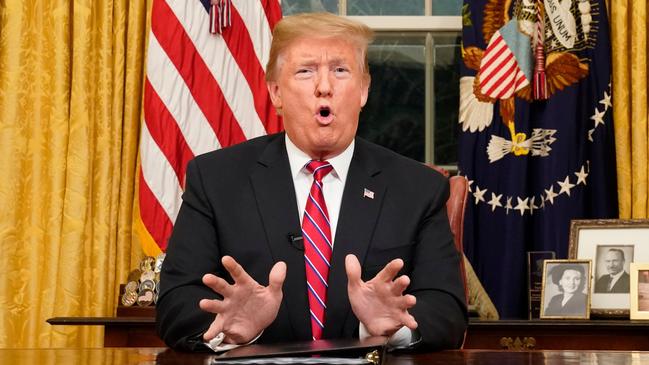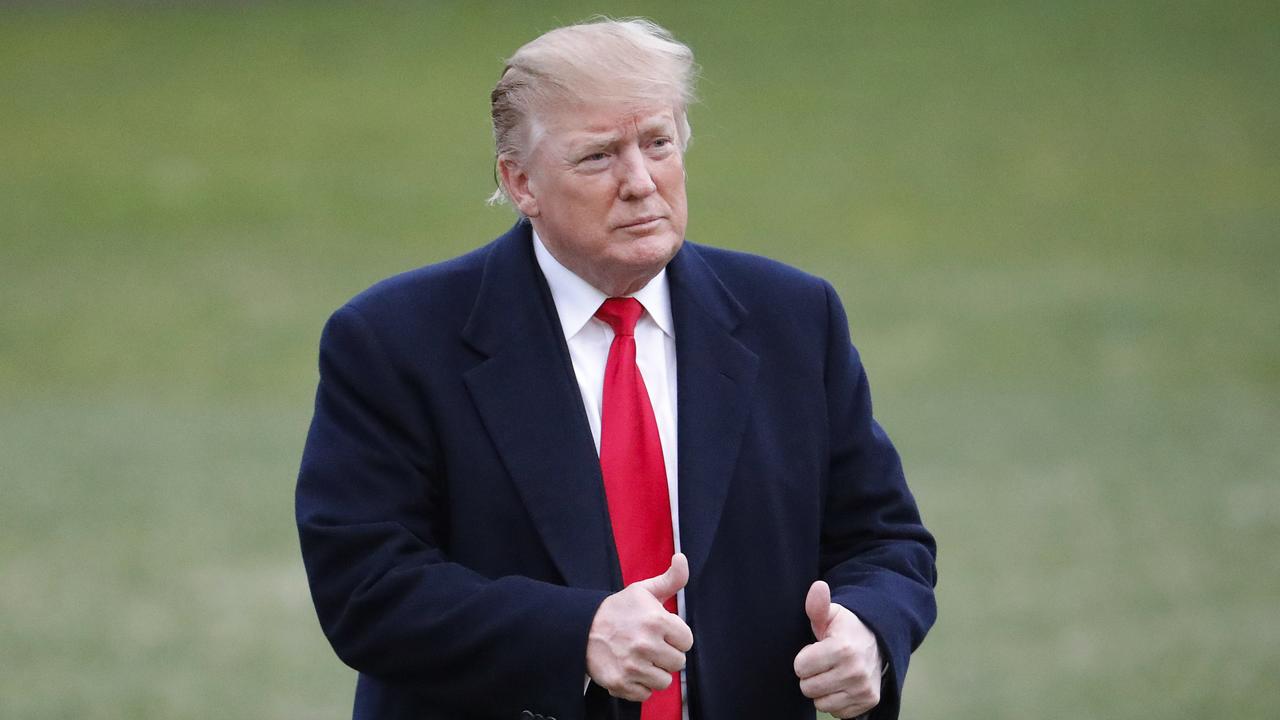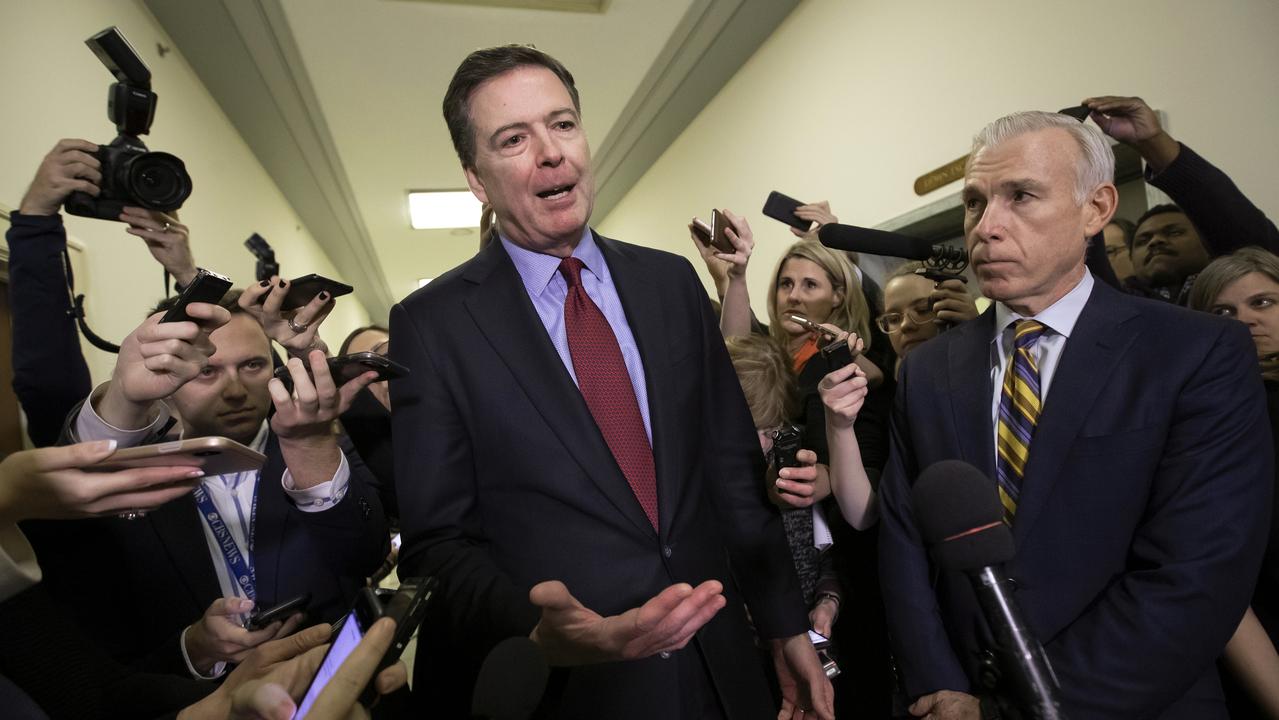The great US border wall stonewall
To understand just how much politics is being played over Trump’s border wall, you need only to look back to 2006.

To understand just how much politics is being played in Washington over Donald Trump’s proposed border wall, you need only look back to 2006.
In that year congress acted to curb illegal border crossings from Mexico into the US by passing the Secure Fence Act authorising the construction of 1050km of barriers along the border — roughly one-third of the almost 3200km border.
Voting in favour of that partial border wall were future Democrat leaders and then senators Barack Obama, Hillary Clinton, Joe Biden and Chuck Schumer.
“The bill before us will certainly do some good,” Obama said on the Senate floor in October 2006. He said the law would provide “better fences and better security along our borders” and would “help stem some of the tide of illegal immigration in this country”.
As president, it was Obama who built most of the present 1050km barrier along the border.
But today’s Democrat leaders, who still include Schumer, say Trump’s proposed wall — this time along the entire US-Mexico border — is now “immoral”.
Democrat house Speaker Nancy Pelosi says: “A wall is an immorality between countries. It’s an old way of thinking. It isn’t cost-effective. We’re not doing a wall.”
As Republican Senate majority leader Mitch McConnell noted this week: “Maybe the Democratic Party was for secure borders before they were against them. Or maybe they’re just making it up as they go along. Or maybe they are that deadset on opposing this particular President on any issue, for any reason, just for the sake of opposing him.”
As Washington tears itself apart over Trump’s proposed wall, the politics of the issue has all but trounced any sober debate about the practical challenges and benefits of the wall itself.
The political stakes suddenly have become sky-high because the deadlock between Democrats and Republicans over funding for the wall is at the centre of what this weekend will become the longest government shutdown in US history. Yesterday Trump said unless a deal could be reached, he was almost certain to declare a national emergency on border security which would allow him to use Pentagon funds to pay for the wall rather than rely on congressional approval from Democrats.
Democrats have chosen to portray Trump’s wall as the single greatest folly of his presidency, a barrier that would speak more to racism and division than to the American tradition of welcoming asylum-seeking immigrants.
It is an attempted moral high ground that is at odds with the party’s own position in 2006 and that also reflects the Democrats’ willingness to play down the problem of illegal immigration to isolate the President.
Yet Trump is equally unsubtle in his political spin over the importance of the wall. His first Oval Office address to the nation this week was riddled with alarmist exaggerations about what he called a “growing humanitarian and national security crisis at our southern border”.
Trump ignored the fact the number of illegal immigrants apprehended for crossing the border hit a 46-year low in 2017 and is now only half the level it was in 2007. He also blamed illegal border crossers for fuelling crime and the opioid epidemic — claims that are inconsistent with a broad range of studies.
Yet illegal immigration is a genuine problem in the US as at least 11 million undocumented migrants are estimated to be living in the country. Although the number of migrants caught for crossing the border has plummeted since 2000, undermining Trump’s claim of a crisis, there were still almost 400,000 apprehended last year. US immigration and border laws are woefully inadequate and they do not allow for anything like the sort of border security enjoyed by Australia.
The key practical questions about Trump’s border wall are whether it is logistically possible, affordable and effective. Trump wants to build at least 1600km of new wall to complement the existing 1050km along the border.
The first half of the US border cuts across California, Arizona and New Mexico following mostly straight lines, but in Texas the border is marked by the winding Rio Grande, which snakes its way for 1900km and would require a feat of engineering to build a wall along it. What’s more, only about one-third of the US border with Mexico is owned by the federal government; the rest is controlled by the states, Native American tribes or is privately owned. To build the wall, Washington must forcibly acquire the land it does not own, guaranteeing protracted legal fights.
Of more concern to congress is the cost. The US government is partially shut down over the Democrats’ refusals to agree to Trump’s demand for $US5.7 billion ($7.9bn) to fund 377km of a “new physical barrier”. Republicans believe the cost of the total wall would be about $US12bn while the Department of Homeland Security has estimated $US21.6bn. The cost of the wall is a major sticking point, even for many Republicans, when the US deficit has ballooned and is on track to top $US1 trillion this year.
Given the practical difficulties and the price tag of the wall, the Trump administration as early as 2017 quietly adopted a more pragmatic approach, even if Trump did not always agree. Officials have largely interpreted Trump’s wall as a catch-all description for a range of measures to tighten border security short of a complete wall from coast to coast. When he was homeland security secretary in 2017, John Kelly said a wall would be built only where it “makes sense” and this would be supplemented with other measures such as greater electronic or human surveillance.
Faced with the present Democrat hostility to the concept of a wall, Trump this week tried to massage the term to make it more politically palatable for the Democrats. During his White House address he described the wall as a “physical barrier” and that “at the request of Democrats, it will be a steel barrier rather than a concrete wall”.
Trump’s determination to demand funding for the wall appears to be driven more by his political circumstances than by a belief that there is a genuine crisis at the border. As President, he has sought to implement his election promises whenever possible, but the wall — his signature election promise — so far has eluded him.
With Trump approaching the halfway mark of his term, he appears to be concerned about a backlash from his base in 2020 if he doesn’t at least start to build the wall. Last month, when he flirted briefly with avoiding the government shutdown by separating funding for the wall from the spending bill, he was savaged by conservative allies. Conservative commentator Ann Coulter called him “gutless” and said she would not vote for Trump in 2020 unless he delivered on the wall. “Nor will, I think, most of his supporters. Why would you?” she said. This backlash is what drove Trump to his hardline position on funding the wall regardless of the government shutdown.
The question of whether a single wall stretching from coast to coast would be effective is hotly debated. Trump says it is “common sense” that a 9m-high wall along the border would be “critically important” in slowing the flow of illegal entries into the US. This is true, but only if the wall was supported by significant and costly new infrastructure including numerous new cameras and more border agents to catch those who tried to climb over or under it. As Obama’s secretary for homeland security, Janet Napolitano, once said: “Show me a 50-foot wall and I’ll show you a 51-foot ladder.”
Democrats argue that money for a wall is better spent on other forms of border security, including more agents and better surveillance.
Trump claimed this week that a border wall would help curtail the flow of illegal drugs into the US that is feeding the country’s opioid epidemic.
But the most deadly drug of the epidemic, fentanyl, is mostly imported into the US from China and those drugs that are largely brought through the southern border, such as heroin, are largely smuggled through established entry points rather than through unfenced parts of the border.
The President also claimed it would help stop criminals from entering the country, although studies consistently show that undocumented migrants are significantly less likely to commit crimes than native-born Americans.
Although Trump has exaggerated the notion of a crisis at the border, he was elected on a platform of cracking down on illegal immigration via all means, including a wall. He is entitled to pursue those promises as part of his mandate regardless of how much it annoys his opponents.
The real question is whether he should be holding the government to ransom by linking his demands with the spending bill, thereby creating the deadlock that has partly shut down the government.
Whether or not a wall is a good idea, polls show that Americans support stronger border security.
US immigration and border laws are ad hoc and weak, and they manifestly have failed to prevent illegal crossings at the southern border. When a migrant is apprehended after illegally crossing the border they are usually released and given a distant court date to hear their case for asylum. They often do not turn up at court but simply stay in the US as one of its 11 million-plus undocumented migrants. For those who choose to apply for asylum through legal entry points, they often wait years for their case to be heard because of an enormous backlog of cases.
Trump’s border security proposal involves a broad range of measures including more immigration judges, border guards, surveillance and detention beds. Ironically, the Democrats agree with many of these measures.
But it is Trump’s wall — the central symbol of his presidency — that threatens to divide Washington well beyond this government shutdown.



To join the conversation, please log in. Don't have an account? Register
Join the conversation, you are commenting as Logout